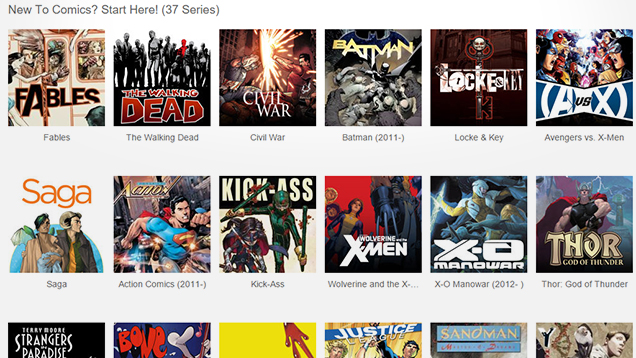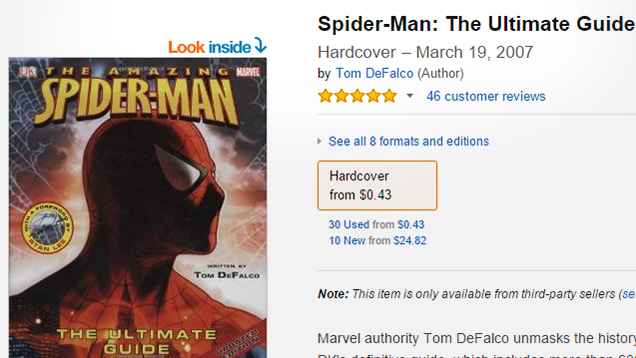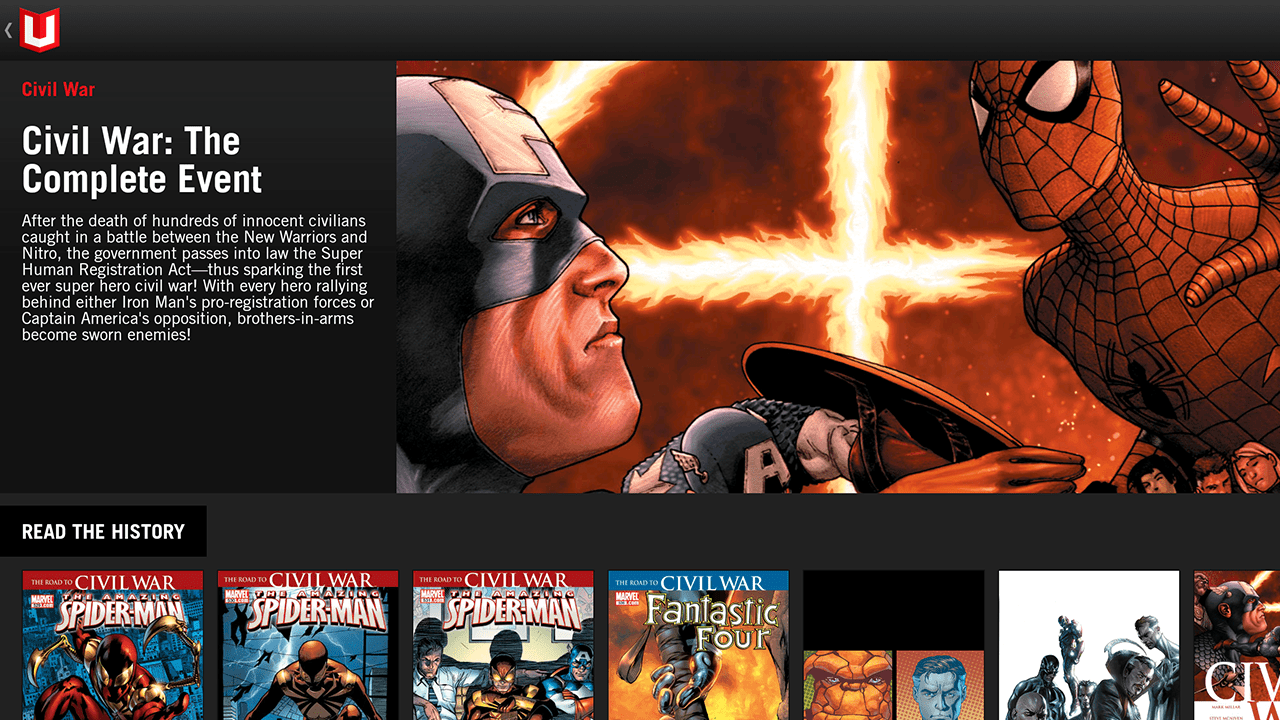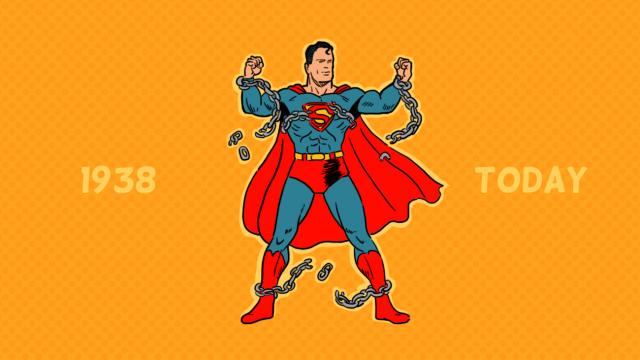Comic book movies are the most popular thing since they started releasing magic movies during the Christmas holidays. Comics themselves, on the other hand, are much harder to get into. Here’s how to find a place to jump in if you’re overwhelmed by decades-long comic book stories.
Decide What You Want to Read About

Everyone has the thing that made them want to start reading comics in the first place. Before you start hunting down issues to read, decide what it is you want to read about:
- Choose a Character: Everyone and their mother is aware of the new Age of Ultron movie coming out. But where did Ultron come from? And who the heck is that weird robot dude? If you’re asking questions like this, you may try taking a character-centric approach. Search apps like Comixology (sometimes called simply “Comics”) for the name of the character you want to read more about. You could also just google around for the best stories about that character (“best ultron stories”) or their origins (“ultron origin”). A little research can go a long way.
- Choose a Story: Comic history is filled with iconic and milestone stories. Some are huge events (which we’ll talk about in a bit) like Civil War. Some are personal stories like Spider-Man No More. If there’s a particular story you’ve heard of and want to read through it, start with that as a foundation.
- Choose a Writer: Once you’ve got a handle on who characters are, following specific writers is a good way to find stuff you really like — not to mention branch out without being overwhelmed by the ocean of comics out there. For example, Frank Miller is well-known for the Batman series The Dark Knight Returns. You won’t always end up reading the same characters — Frank Miller was also known for Daredevil: Born Again, which isn’t even in the same universe as Batman — but following a writer you know you like can be one of the most rewarding ways to read through different series. If you read a story you really like, find out who wrote it and look up some of their other work.
Get Some Context

Unlike Monty Python, you’ll have a hard time beginning at the beginning if you’re a completist. Many major comic book stories have been running for decades and they have changed so much over the years that you’ll probably never go back to the start. Instead, you’ll want to start by getting a little context — reading some of the “classic” storylines, and brushing up on a bit of a character’s history.
There are several ways to get some context. These are a few of the most effective:
- Read Character Bios: Everyone knows who Spider-Man or Batman are, but who are Doctor Strange or Black Panther? The quickest way to find out is to read wiki entries for those characters. While Wikipedia itself has entries for most comic book characters, there are also dedicated wikis for specific publishers.
- Pick Up Character Encyclopaedias: For many characters, you can often find encyclopaedia-style guides that will give you background on a character, as well as reading suggestions for major stories you might be interested in. It’s one of the best ways to get familiar with a character.
- Read Classic Stories: You may not be able to read every comic that’s ever come out, but some older stories are more important than others. For example, if you’re a fan of the MCU, the classic Infinity Gauntlet storyline will do more to help you keep up with the in-references than most other stories. You won’t spend long talking with comic fans before getting a few recommendations for classic stories you can read either.
Keeping up with current comics and getting context on older characters are very different things. Often, the lore and fandom around a character can be found in older stories, or aspects of a character that are accepted as “canon” (which can be pretty flexible, but it still matters a bit). If you want to get to know a character, read up on them first before jumping into their day-to-day.
Find a “Jumping On” Point

So now you’ve read a bit of the classic issues and you want to catch up to the more modern era. Since you aren’t reading from the very beginning, you can find what comic book fans call “jumping on points“. These are parts of the story where you can start reading without being too lost. There are a few different ways to find jumping on points, depending on what you want to read.
Follow a Recent “Event”
Comic book companies love their events. Sometimes, they’re headliners, like the dozenth time Wolverine died, or major crossovers that get turned into movies like Civil War. These can be overwhelming, but they’re also good ways to get acquainted with a large number of characters and the universe as a whole very quickly. Recent “events” will help you get caught up with the status quo of the universe, while older events may help introduce you to characters or ideas that keep coming back.
Modern crossover events can feel particularly daunting though, because universe-spanning events tend to have tie-ins with a dozen other series. Civil War, for example, consists of a seven-issue main event, but there are over 100 issues that tie-in directly or semi-directly. If you really want to get in deep, you can check out reading lists that will tell you which order to read the whole event in, but don’t be afraid to skip the small stuff and just read the main event. It will be a lot less overwhelming, and you’ll get the bits that matter most.
Find Fan or Publisher Reading Lists
Most comic apps and stores have big volumes that contain several smaller issues. These collections usually have a whole story from start to finish in one place. In some older cases, they will be high-profile stories that you’ll see referenced later on. They may be standalone events or even retellings of a character’s origin.
Alternatively, you can check out fan-made reading lists. Fans love recommending comics. While there’s no one place you can visit to find reading lists for everything, if you have the name of a character, event or writer, you can almost always find a solid list of the best stories with a quick Google search.
Even if you don’t know what you want to read, fan sites will help you out. For example, Comic Book Herald has massive reading lists for both Marvel and DC. The Mary Sue also has an excellent collection of Comics 201 guides for navigating the comic world after you get started.
Choose a Writer and Look for “#1” Issues
The coveted “#1” on a comic book is alluring, but it’s not quite accurate to interpret them as the beginning of a characters story. You can think of them more like the start of a particular chapter in the longer story arc. This is particularly handy if you’re following a certain writer.
When a new writer takes over a series, a big fat #1 on the cover can serve as a soft reset on the story. The continuity may not be thrown out, but they will begin the story like this is the first thing you’ve read and (hopefully) intentionally provide context clues to past events where necessary. Sometimes you may even find editor’s notes with references to older comics you may need to read for context. This method isn’t 100 per cent guaranteed to make sense, but it’s better than grabbing the newest comic you see on the shelf.
Once you find a source that you like, keep exploring. The beauty of reading comics is that there’s no single “storyline” that you have to follow. TV shows, movies, and even books have trained us to think that there is a single continuity and you have to start from episode one and watch them in order. Comics are very different. Your favourite characters all exist in the same world, doing their own things in separate stories (until there’s a crossover) and you can pop in and see how any one person or group is doing at any point you choose without necessarily needing to worry about the broader universe.
Learn to Go With the Flow and Just Enjoy the Stories
Comic book movies are 97 per cent origin stories. Comics themselves are the exact opposite — those origins happened decades a. If you decided to read comics because you like the movies and wanted to try your hand at the source material, you can get overwhelmed pretty quickly. Especially if you’re trying to find the comic book version of the movie story you liked to compare.
The Age of Ultron comic is wildly different from the Age of Ultron movie. It features Ultron in the distant future after he’s beaten everyone and rules the world. The upcoming Batman vs Superman film is loosely inspired by The Dark Knight Returns, but that comic is about a near-future Batman who comes out of retirement. Both of these stories aren’t even in the primary continuity of their respective universe. Crazy, right?
Comic books are very different from other media. If you watched the Hunger Games and decided you wanted to read the book, you’d get essentially the same story. If you watched the Avengers and wanted to read the comics, you might find Tony Stark is the head of SHIELD and Ultron’s a woman. Or that they’re called the Illuminati for some reason.
Comics can be daunting, but you can enjoy reading them if you just go with the flow. Some stories are silly, some might make no sense without some context, and you might be left wondering how characters came to be in such wildly different circumstances (like that time Hulk became king of a planet). But treat it less like Game of Thrones and more like Friends. You don’t really need to know every detail of the backstory to follow along. Just jump in wherever seems good to you and enjoy the ride.

Comments
One response to “How To Get Started Reading Comics That Have Been Running For Decades”
Get Marvel Unlimited. Sort by reverse publication date. Start getting psyched about all the original comic runs. Be surprised at all the death and murder in pre-code comics. Get mad that Avengers jumps from issue 1.5 to 127 and the original Hulk series is nowhere to be seen and that many sagas are missing an issue or two.
Then enjoy waiting month to month for 20 minutes of reading =D